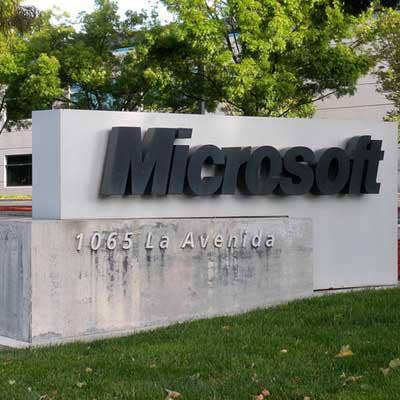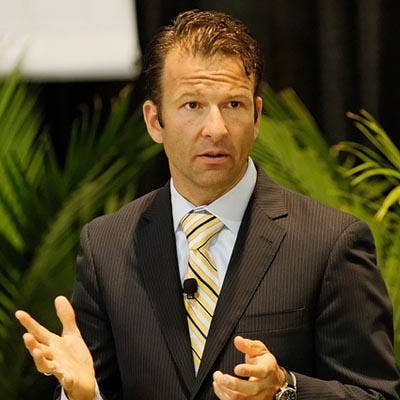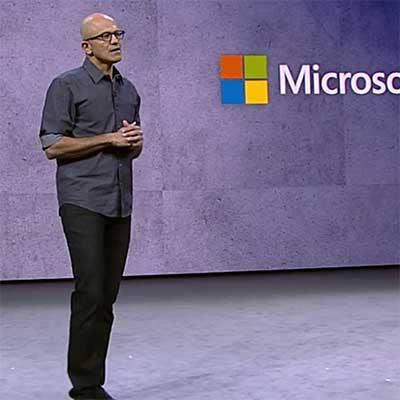The 10 Biggest Microsoft Stories Of 2017

Microsoft Firing On All Cylinders
Microsoft transformed in 2017 and those changes brought along new channel initiatives, next-generation technology investments and significant cloud growth as the software giant shook up its go-to-market strategy and doubled down on partners. The Redmond, Wash.-based company was firing on all cylinders as seen in its latest fiscal quarter earnings results with Microsoft's cloud business already outpacing expectations.
"This quarter we exceeded $20 billion in commercial cloud annual recurring revenues, outpacing the goal we set just over two years ago," said Microsoft CEO Satya Nadella, during its first quarter earnings report in October. In 2017, the company shook up its go-to-market sales model, added new artificial intelligence services and upped the game for partners in its Cloud Solution Provider program.
CRN breaks down the ten biggest stories from Microsoft this year.
Get more of CRN's 2017 tech year in review.

10. IoT Matchmaker
In a move to create new IoT solutions and win more deals for partners, Microsoft in 2017 played matchmaker between its original design manufactures (ODM), original equipment manufacturers (OEM) and channel partners. The company expanded its LINC channel program to refocus on the Internet of Things aimed to further partnerships and help the channel provide end-to-end IoT solutions faster to market. "Everyone talks about IoT, but we want to make it easier for the partner to become connected to other players," said Cindy Wu, global ODM lead at Microsoft, in an interview with CRN. "I want this program to be for any Microsoft partner who wants to get a feel of what IoT could be like … we want to make sure we can cultivate relationships."

9. Free Premium Features Added To Office 365
Microsoft rolled out to Office 365 Home and Office 365 Personal users a number of premium capabilities for their Outlook.com accounts for free. The company made a major move in its email offering lineup in 2017 by cutting off its Outlook.com Premium service offering and injecting some of the service's features into Office 365 customers including ad-free inbox, enhanced security and a higher level of customer support. Office 365 subscribers started to receive additional protection against malware through enhanced scanning of attachments as well as real-time checking of links to discover whether the link is attached to a malicious site, alerting the user if there's a threat.

8. Cycle Computing Acquisition Boosts Azure
In arguably Microsoft's biggest acquisition of 2017, the company acquired cloud computing orchestration firm Cycle Computing to bolster its Azure platform. Greenwich, Conn.-based Cycle Computing provided access to high-performance computing power through the use of resources in the public cloud, with the goal of enabling analytics and other data-intensive workloads. Microsoft leveraged Cycle's technology to enhance its support of Linux high-performance computing workloads and made it easier to extend on-premise workloads to Azure. "Cycle Computing will help customers accelerate their movement to the cloud, and make it easy to take advantage of the most performant and compliant infrastructure available in the public cloud today," said Jason Zander, corporate vice president of Microsoft Azure, at the time of the acquisition.

7. New AI Services
Microsoft launched a slew of artificial intelligence services in 2017 including Bot Framework for integrating chatbots, Azure Machine Learning and Azure IoT Edge service. One key offering is the Azure IoT Edge service which leverages new vital edge analytics capabilities to help IoT devices run cloud services, process data in real time and communicate with sensors and other connected devices. Partners said the services put the heat on competitors like General Electric and AWS. To boost AI across the board, Microsoft also acquired artificial intelligence startup Montreal-based Maluuba this year. That company specialized in improving systems reading comprehension, memory and common sense reasoning abilities.

6. Boosting Cloud Solution Provider Program Incentives
To help partners get a leg up on the competition, Microsoft doubled down on its Cloud Solution Provider (CSP) program. In 2017, Microsoft sales teams started to receive incentives to work alongside solution providers to give partners the total contract value of every Office 365 seat sold through the program. Partners in the program are now working more closely with Microsoft salespeople to close deals such as Enterprise Agreements (EA). "The CSP is no longer the enemy of the EA," said Michael Goldstein, president and CEO of LAN Infotech, a Fort Lauderdale, Fla.-based Microsoft partner, in an interview with CRN. "[Microsoft] understands how big of a barrier it has been in the past."

5. Azure Keeps Up Breakneck Sales Pace
Microsoft Azure market momentum was on full display throughout 2017 with massive growth in cloud services sales including back-to-back quarters of Azure revenues nearly doubling year over year. For fourth fiscal quarter 2017, which ended June 30, Azure sales grew 97 percent compared to the same quarter one year ago. In Microsoft's first fiscal quarter 2018, the company reported Azure sales up 90 percent year over year, boosting Microsoft's $6.9 billion Intelligent Cloud sales business. Customers paying for cloud-based Office 365 services is expected to double in the calendar year 2017 compared to two years ago, with cloud revenues exceeding $15 billion this year. Microsoft's hybrid cloud platform, Azure Stack, also became available for ordering this year from hardware partners like Hewlett Packard Enterprise, Dell EMC and Lenovo.

4. Althoff Leads Channel Charge In Major Restructuring
In a significant move for the channel, Microsoft restructured its sales and marketing teams to focus on specialized markets including business applications, data and artificial intelligence, as well as modern workplace solutions. Significant changes included dividing Microsoft sales groups into two categories: enterprise, and small/medium/corporate. Microsoft sales teams was also reorganized by industry focus and product category. Judson Althoff, executive vice president of Worldwide Commercial Business, will lead the charge. He said there are six new priority vertical opportunities for partners in government, retail, education, healthcare, financial services and manufacturing. "Customers are asking us to understand their business and marry our technology to help them with their businesses," said Althoff.

3. Huddleston Tasked To Drive New 'One Commercial Partner' Business
Partners cheered as Microsoft launched a sweeping reorganization that consolidated several of the company's partner and services teams, while also creating a new cloud-focused group to accelerate cloud services sales in the channel. The company's new 'One Commercial Partner' business combined its ISV, Enterprise Partner and Worldwide Partner teams, as well as a new Microsoft Digital group to incent partners to sell its cloud services. The changes were designed to unify teams from across the Commercial Business to make it easier to do business with partners. Tasked with the leading the new group is Ron Huddleston, corporate vice president of the One Commercial Partner Organization, who joined the company in June. Huddleston told CRN that Microsoft's salespeople are being incentivized to work more closely with partners. "If our sales rep is selling with you, we're asking you to tell us how much you sold your solution for, and we're paying [the sales rep] on the partner's solution. That's unheard of in the industry. No one pays their salespeople on someone else's stuff," he said.

2. Consumption-Based Compensation Models Change The Game
In a significant move to shift toward generating more recurring revenues compared to up-front sales, Microsoft changed its sales organization in 2017 to strongly emphasize sales that can be accrued over time. Microsoft's salespeople are now being compensated based on consumption of Azure rather than pre-committed sales. Partners welcomed the consumption-based compensation model as some customers lack large upfront CapEx dollars needed for digital transformation. Tony Safoian, president and CEO of Los Angeles-based SADA Systems, recently told CRN that the move is "the sales model of the future" and will help partners capture new recurring revenues. "It may seem like it's slowing down the licensing sale, and it may be. But when the customer is ready to buy, they'll be buying something bigger than they thought they needed," said Safoian. The new consumption model lines Microsoft and its channel community up for strong growth heading into 2018.

1. Satya Nadella Makes His Mark
Microsoft CEO Satya Nadella was attacking on all fronts in 2017 as revenue climbed by double digits year over year during each quarter in key areas like Microsoft Azure and its Office 365 commercial business. The growth helped boost the company's stock up nearly 40 percent this year, starting at around $62 per share in January to surpassing $86 per share in December.
Nadella played a significant role this year expanding Microsoft's cloud business, reaching its $20 billion commercial cloud run rate goal ahead of schedule. Additionally, Windows 10 reached 600 million active monthly devices by the end of 2017. The CEO is also driving the company deeper into artificial intelligence and machine learning, saying Microsoft is just starting "a complete new journey of building these AI-first business applications." Momentum doesn't appear to be slowing down heading into the new year, as Microsoft reported a 12-percent increase in revenues to $24.5 billion for its first fiscal quarter 2018, which ended in October.